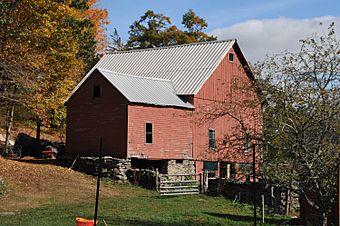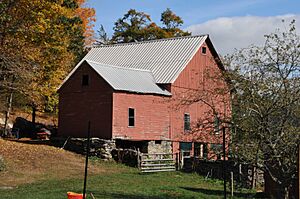Capt. Thomas Fanning Farmstead facts for kids
Quick facts for kids |
|
|
Capt. Thomas Fanning Farmstead
|
|

The farmstead's barn
|
|
| Location | 1004 Shewville Rd., Ledyard, Connecticut |
|---|---|
| Area | 4 acres (1.6 ha) |
| Built | 1746 |
| Built by | Fanning, Thomas |
| Architectural style | Colonial, Postmedieval English |
| MPS | Ledyard MPS |
| NRHP reference No. | 92001643 |
| Added to NRHP | December 14, 1992 |
The Capt. Thomas Fanning Farmstead is a very old farm in Ledyard, Connecticut. It has a house, a barn, and other small buildings. This farm started around 1746. It is one of the oldest farms still standing in Ledyard. Today, the farm covers about 4 acres. It was added to the National Register of Historic Places in 1992. This means it's an important historical site.
Exploring the Fanning Farmstead
The Captain Thomas Fanning Farmstead is in a quiet, countryside area. It is located in northern Ledyard, close to the town of Preston. The farm sits on four acres of land. The main buildings are grouped around a grassy field.
The Farmhouse and Other Buildings
The main house is a 1-1/2 story building. It is built from wood and has a central chimney. This style is called "Cape style." The front of the house faces away from the road, towards the southeast. It has five windows or doors across the front. The main door is in the middle. A part of the house with a sloped roof sticks out towards the street.
Around the grassy field, you can find other farm buildings. There is a barn that dates back to the 1700s. There are also several buildings from the 1800s. These include a corn crib, a blacksmith shop, sheds, and another small barn. Some of these buildings are built on foundations that are even older than the buildings themselves.
A Look Back in Time: The Farm's History
The story of this farm began in 1746 or 1747. That's when Thomas Fanning bought 100 acres of land. He bought it from Jonathan Brewster, who lived in Preston. There was already a barn on the property when Fanning bought it.
Thomas Fanning built part of the house soon after. This first part was about three sections wide. Later, his son Frederick probably made the house wider. Frederick took over the farm in 1789. He then sold the farm to his brother-in-law in 1793.




